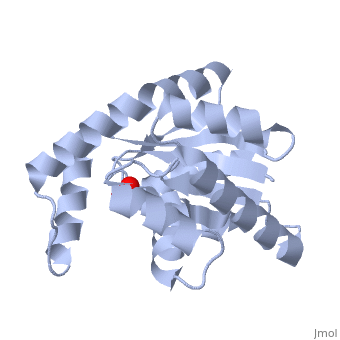1tev: Difference between revisions
m Protected "1tev" [edit=sysop:move=sysop] |
No edit summary |
||
| Line 1: | Line 1: | ||
[[Image: | ==Crystal structure of the human UMP/CMP kinase in open conformation== | ||
<StructureSection load='1tev' size='340' side='right' caption='[[1tev]], [[Resolution|resolution]] 2.10Å' scene=''> | |||
== Structural highlights == | |||
<table><tr><td colspan='2'>[[1tev]] is a 1 chain structure with sequence from [http://en.wikipedia.org/wiki/Homo_sapiens Homo sapiens]. Full crystallographic information is available from [http://oca.weizmann.ac.il/oca-bin/ocashort?id=1TEV OCA]. For a <b>guided tour on the structure components</b> use [http://oca.weizmann.ac.il/oca-docs/fgij/fg.htm?mol=1TEV FirstGlance]. <br> | |||
</td></tr><tr><td class="sblockLbl"><b>[[Ligand|Ligands:]]</b></td><td class="sblockDat"><scene name='pdbligand=SO4:SULFATE+ION'>SO4</scene><br> | |||
<tr><td class="sblockLbl"><b>[[Gene|Gene:]]</b></td><td class="sblockDat">UCK ([http://www.ncbi.nlm.nih.gov/Taxonomy/Browser/wwwtax.cgi?mode=Info&srchmode=5&id=9606 Homo sapiens])</td></tr> | |||
<tr><td class="sblockLbl"><b>Activity:</b></td><td class="sblockDat"><span class='plainlinks'>[http://en.wikipedia.org/wiki/Cytidylate_kinase Cytidylate kinase], with EC number [http://www.brenda-enzymes.info/php/result_flat.php4?ecno=2.7.4.14 2.7.4.14] </span></td></tr> | |||
<tr><td class="sblockLbl"><b>Resources:</b></td><td class="sblockDat"><span class='plainlinks'>[http://oca.weizmann.ac.il/oca-docs/fgij/fg.htm?mol=1tev FirstGlance], [http://oca.weizmann.ac.il/oca-bin/ocaids?id=1tev OCA], [http://www.rcsb.org/pdb/explore.do?structureId=1tev RCSB], [http://www.ebi.ac.uk/pdbsum/1tev PDBsum]</span></td></tr> | |||
<table> | |||
== Evolutionary Conservation == | |||
[[Image:Consurf_key_small.gif|200px|right]] | |||
Check<jmol> | |||
<jmolCheckbox> | |||
<scriptWhenChecked>select protein; define ~consurf_to_do selected; consurf_initial_scene = true; script "/wiki/ConSurf/te/1tev_consurf.spt"</scriptWhenChecked> | |||
<scriptWhenUnchecked>script /wiki/extensions/Proteopedia/spt/initialview01.spt</scriptWhenUnchecked> | |||
<text>to colour the structure by Evolutionary Conservation</text> | |||
</jmolCheckbox> | |||
</jmol>, as determined by [http://consurfdb.tau.ac.il/ ConSurfDB]. You may read the [[Conservation%2C_Evolutionary|explanation]] of the method and the full data available from [http://bental.tau.ac.il/new_ConSurfDB/chain_selection.php?pdb_ID=2ata ConSurf]. | |||
<div style="clear:both"></div> | |||
<div style="background-color:#fffaf0;"> | |||
== Publication Abstract from PubMed == | |||
Human UMP/CMP kinase plays a crucial role in supplying precursors for nucleic acid synthesis by catalyzing the conversion of UMP, CMP, and dCMP into their diphosphate form. In addition, this kinase is an essential component of the activation cascade of medicinally relevant nucleoside analog prodrugs such as AraC, gemcitabine, and ddC. During the catalytic cycle the enzyme undergoes large conformational changes from open in the absence of substrates to closed in the presence of both phosphoryl donor and phosphoryl acceptor. Here we report the crystal structure of the substrate-free, open form of human UMP/CMP kinase. Comparison of the open structure with the closed state previously reported for the similar Dictyostelium discoideum UMP/CMP kinase reveals the conformational changes that occur upon substrate binding. We observe a classic example of induced fit where substrate-induced conformational changes in hinge residues result in rigid body movements of functional domains to form the catalytically competent state. In addition, a homology model of the human enzyme in the closed state based on the structure of D. discoideum UMP/CMP kinase aids to rationalize the substrate specificity of the human enzyme. | |||
Substrate-induced conformational changes in human UMP/CMP kinase.,Segura-Pena D, Sekulic N, Ort S, Konrad M, Lavie A J Biol Chem. 2004 Aug 6;279(32):33882-9. Epub 2004 May 26. PMID:15163660<ref>PMID:15163660</ref> | |||
From MEDLINE®/PubMed®, a database of the U.S. National Library of Medicine.<br> | |||
</div> | |||
== References == | |||
<references/> | |||
__TOC__ | |||
</StructureSection> | |||
== | |||
< | |||
[[Category: Cytidylate kinase]] | [[Category: Cytidylate kinase]] | ||
[[Category: Homo sapiens]] | [[Category: Homo sapiens]] | ||
Revision as of 23:24, 29 September 2014
Crystal structure of the human UMP/CMP kinase in open conformationCrystal structure of the human UMP/CMP kinase in open conformation
Structural highlights
Evolutionary Conservation Check, as determined by ConSurfDB. You may read the explanation of the method and the full data available from ConSurf. Publication Abstract from PubMedHuman UMP/CMP kinase plays a crucial role in supplying precursors for nucleic acid synthesis by catalyzing the conversion of UMP, CMP, and dCMP into their diphosphate form. In addition, this kinase is an essential component of the activation cascade of medicinally relevant nucleoside analog prodrugs such as AraC, gemcitabine, and ddC. During the catalytic cycle the enzyme undergoes large conformational changes from open in the absence of substrates to closed in the presence of both phosphoryl donor and phosphoryl acceptor. Here we report the crystal structure of the substrate-free, open form of human UMP/CMP kinase. Comparison of the open structure with the closed state previously reported for the similar Dictyostelium discoideum UMP/CMP kinase reveals the conformational changes that occur upon substrate binding. We observe a classic example of induced fit where substrate-induced conformational changes in hinge residues result in rigid body movements of functional domains to form the catalytically competent state. In addition, a homology model of the human enzyme in the closed state based on the structure of D. discoideum UMP/CMP kinase aids to rationalize the substrate specificity of the human enzyme. Substrate-induced conformational changes in human UMP/CMP kinase.,Segura-Pena D, Sekulic N, Ort S, Konrad M, Lavie A J Biol Chem. 2004 Aug 6;279(32):33882-9. Epub 2004 May 26. PMID:15163660[1] From MEDLINE®/PubMed®, a database of the U.S. National Library of Medicine. References
|
| ||||||||||||||||||||
